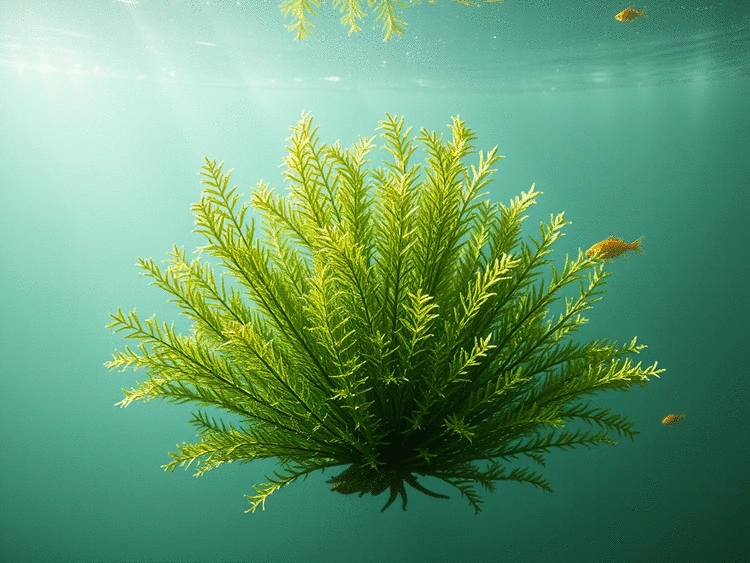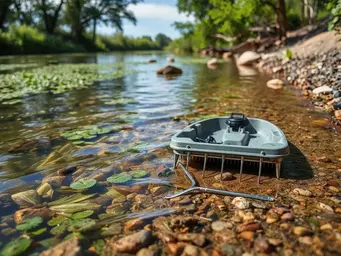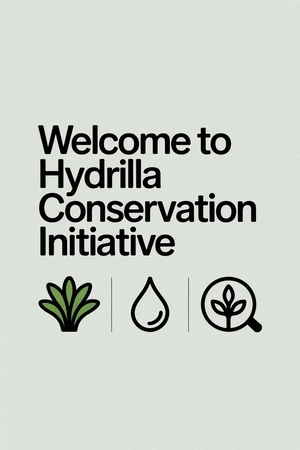Have you observed how quickly certain invasive plants can transform entire ecosystems? Hydrilla, with its remarkable adaptability and resilience, serves as a prime example of this phenomenon. Understanding its unique biological traits is essential for effective management and conservation strategies.
What You Will Learn
- Hydrilla's ability to form dense mats disrupts native plant growth by blocking sunlight.
- Its unique vegetative reproduction allows it to colonize new areas rapidly from just a stem fragment.
- Hydrilla can survive in a wide range of environmental conditions, showcasing its adaptability to light and salinity levels.
- The ecological impact of hydrilla includes habitat loss for native species and altered water chemistry, leading to decreased biodiversity.
Hydrilla's Remarkable Adaptations and Ecological Impact
This visual highlights Hydrilla's key characteristics, growth strategies, and profound ecological impact, showcasing why it is such a formidable invasive species.
Characteristics & Growth
- ✓ Whorled leaves (5-7)
- ✓ Up to 30ft long stems
- ✓ Rapid biomass doubling
- ✓ Morphology adapts to light
Reproductive Strategies
- ● Vegetative fragmentation
- ● Dormant tubers (energy storage)
- ● Sexual reproduction (less common)
Physiological Adaptations
- ★ Tolerance to low light
- ★ High salinity tolerance
- ★ Wide temperature adaptability
Ecological Impact
- ✗ Displaces native species
- ✗ Disrupts fish habitats
- ✗ Alters water chemistry
- ✗ Oxygen depletion from decay
Understanding Hydrilla's Unique Biology and Ecological Adaptations
As an aquatic biologist, I often delve into the fascinating world of invasive species, and hydrilla (Hydrilla verticillata) stands out due to its remarkable adaptations. This plant has developed unique characteristics that enable it to thrive in various freshwater environments. Have you ever wondered why hydrilla seems to outcompete native species? Let's explore its biology and ecological adaptations to understand this phenomenon better.
Characteristics of Hydrilla Verticillata as an Invasive Plant
Hydrilla has a range of distinctive features that contribute to its invasive nature. Its leaves are typically arranged in whorls of five to seven, and the plant can grow up to 30 feet long, often forming dense mats on the water's surface. These mats can block sunlight, which is detrimental to native aquatic plants. Additionally, hydrilla can adapt its morphology based on the environmental conditions it faces. For instance, in low-light conditions, it can develop longer stems with fewer leaves, allowing it to reach for sunlight more effectively. For more detailed information on its characteristics and impact, you can refer to resources like the study on Hydrilla's morphological and physiological adaptations.
- Growth form: Submersed, often forming dense mats.
- Leaf arrangement: Whorls of 5-7 leaves.
- Growth rate: Rapidly grows and can double its biomass in a matter of days.
These characteristics make hydrilla not just a pretty plant but a formidable competitor in our waterways. Understanding these traits is crucial for effective management strategies!
Growth and Reproductive Strategies: Vegetative Reproduction and Beyond
One of hydrilla's most impressive abilities is its reproductive strategy. Hydrilla predominantly reproduces vegetatively, meaning it can grow new plants from fragments of its stems. This capability allows a single piece of hydrilla to lead to extensive colonies if it is not managed properly. Interestingly, hydrilla can also produce tubers—small, potato-like structures that store energy and can survive unfavorable conditions. This dual approach to reproduction makes control efforts particularly challenging.
- Fragmentation: Small stem pieces can establish new plants.
- Tubers: Dormant structures that can survive for years.
- Sexual reproduction: Although less common, hydrilla can also produce flowers and seeds.
Have you seen how quickly hydrilla can take over a waterbody? Understanding these growth strategies is essential for anyone involved in managing invasive aquatic plants!
Physiological and Molecular Adaptations to Environmental Stressors
Hydrilla is equipped with various physiological adaptations that allow it to thrive in diverse and often challenging environments. For instance, it shows remarkable tolerance to low light, high salinity, and varying temperatures. This resilience is largely due to its ability to modify its metabolic processes, enabling it to photosynthesize efficiently even in less-than-ideal conditions. These adaptations not only help it survive but also promote its rapid growth. Research, such as the study on Hydrilla's physiological adaptations, provides further insights into its success.
- Light tolerance: Can adapt to low-light environments.
- Salinity tolerance: Able to survive in brackish waters.
- Temperature adaptability: Thrives in a range of water temperatures.
Such adaptations make hydrilla a particularly successful invader, capable of colonizing various habitats and impacting local ecosystems.
Ecological Impact of Hydrilla on Freshwater Ecosystems
The ecological impact of hydrilla is profound and often detrimental to native biodiversity. This invasive plant can outcompete native species for sunlight, nutrients, and space. The dense mats formed by hydrilla can disrupt the habitat of fish and other aquatic organisms, leading to decreased biodiversity. It can also alter water chemistry, impacting the overall health of the ecosystem, including oxygen levels and nutrient cycling. According to resources like Cornell Cooperative Extension's information on ecological impacts, hydrilla's presence significantly alters aquatic environments.
- Habitat loss: Displacement of native plants and animals.
- Nutrient cycling: Changes in water quality and availability of resources.
- Oxygen depletion: Plant decay leads to reduced dissolved oxygen levels in water.
As someone passionate about environmental education, I can't stress enough how vital it is to raise awareness about hydrilla's impacts on our precious ecosystems!
Competitive Advantages: How Hydrilla Thrives in Various Habitats
Hydrilla's success as an invasive species can be attributed to its competitive advantages. It can thrive in a range of freshwater habitats, from lakes and ponds to rivers and canals! This adaptability allows it to spread rapidly. Furthermore, hydrilla's growth can be enhanced by nutrient-rich waters, often leading to explosive population increases.
- Versatile habitat preferences: Thrives in varying depths and flow conditions.
- Enhanced nutrient uptake: Can exploit nutrient-rich water bodies.
- Rapid reproduction: Quickly occupies available space, outcompeting natives.
This versatility makes hydrilla a persistent challenge for conservation efforts. As we work through strategies to manage this invasive plant, understanding its competitive edge is essential for crafting effective solutions!
Frequently Asked Questions About Hydrilla
What are the main characteristics of Hydrilla?
Hydrilla is a submersed aquatic plant characterized by whorled leaves (5-7 per whorl) and stems that can grow up to 30 feet long. It forms dense mats on the water's surface and can adapt its morphology to optimize light capture.
How does Hydrilla reproduce?
Hydrilla primarily reproduces vegetatively through fragmentation, where small stem pieces can establish new plants. It also produces dormant tubers that can survive unfavorable conditions for years and, less commonly, reproduces sexually via flowers and seeds.
What physiological adaptations help Hydrilla survive?
Hydrilla exhibits remarkable tolerance to low light, high salinity, and varying temperatures. These adaptations allow it to modify its metabolic processes and photosynthesize efficiently in diverse and challenging environments.
What is the ecological impact of Hydrilla?
Hydrilla significantly impacts freshwater ecosystems by displacing native species, disrupting fish habitats, and altering water chemistry. Its dense mats block sunlight, and its decay can lead to oxygen depletion, reducing overall biodiversity.
Why is Hydrilla considered a successful invasive species?
Hydrilla's success stems from its competitive advantages, including versatile habitat preferences (thriving in various depths and flow conditions), enhanced nutrient uptake in rich waters, and rapid reproductive capabilities, which allow it to quickly colonize and outcompete native plants.
I couldn't find a specific video titled "Comparative Analysis of Hydrilla's Ecological Adaptations Across Different Waterways." However, a video titled "Hydrilla Hazard: Biology, Impacts and Management of an Invasive Aquatic Plant" provides comprehensive information on hydrilla and its ecological impacts. Here is the embed code for this video:
We Want to Hear From You!
How do you think hydrilla impacts your local waterways? Share your experiences or observations below:
Summarizing the Findings on Hydrilla's Ecological Adaptations
As we delve into the complexities of hydrilla, it becomes clear that this invasive plant has developed remarkable ecological adaptations that allow it to thrive in a range of environments. Understanding these adaptations is crucial not only for managing hydrilla but also for safeguarding our precious waterways. Let’s take a moment to reflect on some of the key findings from our comparative analysis of hydrilla's behavior across different ecosystems!
Key Takeaways from the Comparative Analysis of Hydrilla's Behavior
Our exploration of hydrilla’s growth patterns reveals several important insights that every environmental professional should consider:
- Hydrilla exhibits distinct growth advantages in both rivers and lakes, adapting its strategies to maximize reproductive success.
- The plant's vegetative reproduction allows it to rapidly colonize new areas, leading to significant ecological shifts.
- Hydrilla's ability to tolerate a range of water temperatures and salinity levels contributes to its resilience in various habitats.
These key points highlight why hydrilla poses such a challenge to native ecosystems. By recognizing these behaviors, we can better tailor our management approaches to minimize their impact. Have you observed similar patterns in your local waterways?
Future Research Directions and the Importance of Continued Monitoring
As we look ahead, it's essential to prioritize ongoing research and monitoring efforts related to hydrilla. Here are some future directions that we believe can enhance our understanding:
- Investigating the genetic diversity of hydrilla populations to determine their adaptability to environmental changes.
- Studying the long-term effects of hydrilla management on native aquatic species and overall ecosystem health.
- Exploring innovative control methods that may be more effective and sustainable in the long run.
By focusing on these areas, we can develop more effective strategies for managing hydrilla and protecting our vital aquatic ecosystems. What new avenues of research do you think should be explored?
The Importance of Environmental Monitoring in Assessing Hydrilla Control Methods
Effective management of hydrilla relies heavily on environmental monitoring. Here's why it plays a critical role:
- Continuous assessment of water quality helps identify areas where hydrilla is likely to proliferate.
- Monitoring native species populations gives us insight into how hydrilla impacts biodiversity.
- Tracking management outcomes allows for real-time adjustments to strategies, improving effectiveness.
As part of the Hydrilla Conservation Initiative, I believe that engaging in thorough monitoring not only empowers us but also builds a stronger community dedicated to conservation. What monitoring practices have you found effective in your own efforts?
Recap of Key Points
Here is a quick recap of the important points discussed in the article:
- Distinct Characteristics: Hydrilla has a unique morphology, including whorled leaves and the ability to grow up to 30 feet long, forming dense mats that block sunlight.
- Reproductive Strategies: Primarily reproduces vegetatively and can produce tubers, making it difficult to control.
- Physiological Adaptations: Exhibits tolerance to low light, high salinity, and varying temperatures, enhancing its survival in diverse habitats.
- Ecological Impact: Causes habitat loss and nutrient cycling changes, leading to decreased biodiversity and oxygen depletion in water bodies.
- Competitive Advantages: Thrives in various freshwater habitats and exploits nutrient-rich waters, enabling rapid population increases.






